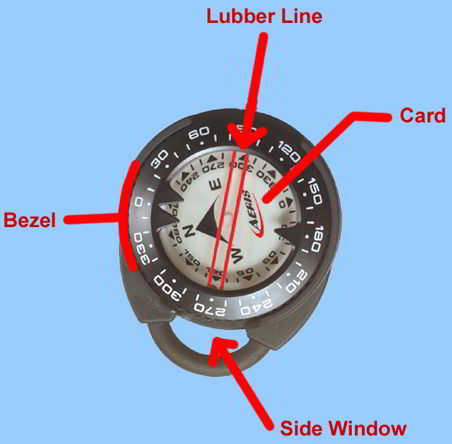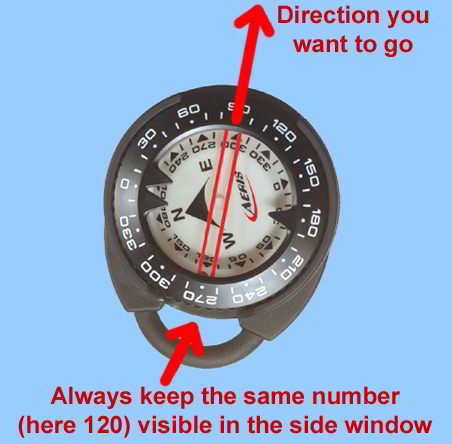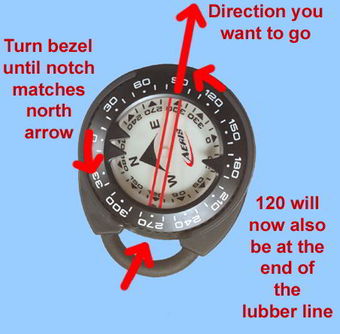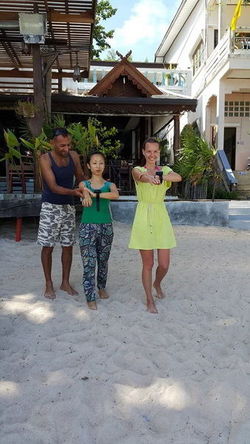- Home
- News
During your diving on Koh Tao you will be always suggested to use a compass navigation on the dive sites.
All of us had an introduction to underwater navigation with using dive compass during our PADI Open Water Diver course, but on fun dives, most of the divers prefer to follow the divemaster, whereas knowing exactly where you’re going, where you’ve been and where you are at any given time underwater. It definitely makes diving on Koh Tao a lot more enjoyable and stress-free.
Compass navigation underwater is a piece of cake, just follow few simple rules:



1). Point the long line on your compass (the lubber line) in the direction you want to swim and make sure your body is pointed in the same direction.
2). Rotate the bezel on the top of the compass until the two hatch marks meet the North arrow. As you swim, watch to make sure the North arrow stays between those marks.
3). Keep the compass flat and in line with your body at all times. If you get off-course, turn your whole body, not just the compass, until your heading is back on track.
4). Look up and around periodically to keep an eye on your surroundings. If there is a current or heavy surge, you can be pushed off-course, even if your heading stays true.
5). To return to your starting point, turn your body until the North arrow points at the single hatch mark on the other side of the bezel.
6). Trust your compass. If there is a discrepancy between what you feel and what your compass is telling you, go with the compass. You may not know exactly where you but your compass can point you in the right direction until you recognize one of those land marks you saw on the way out.
7). Get some training. Like every other skill in diving, practice will make you a first-rate navigator, which will open you up to a wider variety of diving possibilities.
And a great way to learn these skills is by taking PADI Underwater Navigation course on Koh Tao or Samui, which provides hands-on training, both on the surface and underwater, and allows you to practice with an experienced navigator (your instructor) on Koh Tao’s dive sites

Diving on Koh Tao and Samui Islands presents a lot of symbiotic relations of aquatic life of the Gulf of Thailand.
Everyone knows about symbiotic relations between anemones and clownfish (good example you could see on the dive sites Twins and White rock around Koh Tao), but there is some more interesting partnership between different species under the sea. If you look a little further down on the sandy bottom during your dive at Twins, close to Koh Nang Yuan, you can easily find just perfect partners both of which benefit from their relationship. We are talking about Pistol (snapping) shrimp and Prawn Goby.
The shrimp who builds a burrow in the sand surrounded by shells has very poor eyesight so cannot see any potential danger coming to destroy its
PADI Underwater Naturalist is a brilliant diving course for learning new staff about Koh Tao inhabitants.
Buoyancy World is an artificial dive site in Koh Tao island, located near NangYuan Island, the most popular dive spot in Thailand. The dive site was constructed on a sandy bottom at around 12m depth by Save Koh Tao organization in collaboration with a number of the island's dive centers to provide a training area for new divers, so they don't damage the natural reef when learning buoyancy control.

It also includes coral and fish nursery which aims to restore and improve the abundance and biodiversity of Koh Tao's reefs. Expect to see very friendly Red-breasted wrasse, groups of Batfish, White-eyed morays, Parrotfish, few species of Butterflyfish. This dive site consists of sculptures, including a huge shark, an octopus, a gecko, a small “shipwreck”, the Himmapan trees and various hoops, tunnels and cages and very much has the feel of an underwater playground. Buoyancy World is an excellent place for PADI Open Water Diver course training dive, as well as PADI Underwater Navigation course and PADI Peak Performance Buoyancy course.
If you want to learn how to take great pictures underwater than PADI Digital Underwater Photographer specialty course in our dive center on Koh Tao or Samui is exactly what you are looking for!
This course conducted on the beautiful coral reefs in Koh Tao and Koh Nang Yuan islands, the most popular dive spots in Thailand.
So, you really need to know how to dive with a camera without harming the reef.
The PADI Digital Underwater Photographer course will get you going quickly with today’s modern digital equipment regardless of what type of digital camera you use. You will not just learn how to capture some great underwater memories on dive sites around Koh Tao, but will also improve your buoyancy and general diving skills in the process.
What will you learn:
— How to choose the right underwater camera system for you
— PADI «Shoot, Examine, Adjust» method for getting great shots quickly
— Principles for good composition of underwater images
— Practical techniques to take great shots with your digital camera while diving in Koh Tao
This course consists of two dives and can be completed in one day. You will start with some theory review and then practice underwater, taking photographs.
PADI (Junior) Open Water Divers who are at least 10 years old are eligible to take the Digital Underwater Photographer course.
Shipwreck the HTMS Sattakut (LCI [Landing Craft Infantry] — 742) is one of the favorites and most visited dive sites at Koh Tao island, Thailand.
Dive site located at a 20 minutes distance from Koh Tao and it’s the most popular dive site for PADI Advanced Open Water Diver course and PADI Wreck specialty diving course.
At 48 meters in length, this former US World War II Navy vessel was commissioned into the Royal Thai Navy in 1947 where it served until it was decommissioned in 2007.
Previously, as a US Navy ship it most famously participated in The Battle of Iwo Jima — one of the fiercest and most strategic battles between the USA and Japan during World War II.
On the 18th June 2011 after cleaning and stripping the vessel of all toxins and hazardous materials, the Thai Department of Marine and Coastal Resources purpose-sank the ship just off the coast of Koh Tao as a new artificial reef and dive site.
Now, the Sattakut is home to large schools of Fusilier, various Snapper, Wrasse, Groupers, Trevally, Rabbitfish, Jenkins Whipray as well as small Blennies living in the small holes of the structure.
The wreck’s base sits in the sand at a maximum depth of between 27 and 30 meters (depending which end) while the top of the mast protrudes to a depth of approximately 18 meters — making this dive most suitable for divers with the PADI Advanced Open Water or above.
Over the past 5 years, the HTMS Sattakut Wreck has become a part of almost every PADI Advanced Open Water course, making it one of our most frequently visited dive sites in Koh Tao and Samui islands. It is also a perfect dive site for PADI Wreck Specialty course and technical diver training.


